|
30th June
Musselburgh and Port Seton
Showers
and sunny intervals were expected throughout Central Scotland on
Sunday, with the brightest spells in the East. Hence we found ourselves
driving to Musselburgh, very familiar territory for us, with always
with something of interest. So after a pit stop at Dalkeith Morrisons
(7/10: poor egg and cool, tough bacon), we started off at the Millhill
car park, overlooking an island on the River Esk. It is a popular spot
for people to stop and feed the birds. However, there were small
notices on lampposts warning them against this, citing a long list of
bad
consequences for
the birds should they be fed bread. As I photographed a Lesser
Blackbacked Gull I thought it looked a bit forlorn, or maybe that was
just my imagination. A 2nd-year Herring Gull, with obvious patches of
adult plumage, stood awaiting any pedestrian brave enough to ignore the
notices, while on the water first year Lesser Black-backed Gulls paddled
nervously. A mother Mallard guided her ducklings towards the slipway,
perhaps hoping there were easy pickings there (also see,
“Pictures of
the Week”, below).
| Lesser Black-backed Gull |
2nd Cycle Herring Gull |
1st
Cycle Lesser
Black-backed Gull |
Female Mallard |

|

|

|

|
We
next strolled upstream seeking a sighting of a Dipper. Alas we
didn’t
see one, but we were pleased to see some Canada Geese in the distance
by the Old Bridge. On our way down to check them out we passed some
Jackdaws scouring the grass for invertebrates. At the bridge I noticed
a White Wagtail with a mouthful of invertebrates. It couId be an
immature male Pied
Wagtail
though. It flew off over the Canada Geese. John pointed out that there
were two broods of goslings, obviously, from their sizes, of different
ages.
| Jackdaw |
White
/ Pied
Wagtail |
Canada Geese Goslings |
Canada Goose |

|

|

|

|
On the river island was
a Giant
Hogweed
plant that was over 4 metres high. It has been called the
UK’s most
dangerous plants as it can cause life-threatening burns if
handled. A
Moorhen was scurrying around its base. We decided to travel to the
mouth of the Esk, parking at the Cadet Hall. The tide was high so most
of the birds we’d expected to see had flown. We did see
Goosanders and
Eider. I managed a nice shot of a female Eider making short work of a
crab (see, “Pictures of the Week”, below). John
drew my attention to a
hybrid goose travelling down the river, a cross of Canada and Greylag
Geese.
| Giant Hogweed |
Moorhen |
Female Goosander |
Canada/Greylag Hybrid |

|
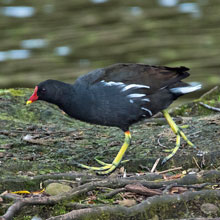
|

|

|
Across the mouth of the
River were over twenty Mute Swans holding their positions but not
seeming to do much else.
We
returned to the car and I drove to the Levenhall Links car park. We
walked across the mown fields towards the Nature Reserve. In the verges
of long grass there were attractive outcrops of Pineapple
Mayweed .
It is a non-native plant, an escape from Kew Gardens in London. It is a
favourite of foragers and it has been used for medicinal purposes. Many
tiny yellow “pompoms” of Black
Medick,
another wildflower used in herbal medicine , was by the
pathside. At
first I thought it was Hop Trefoil, but the tell-tale details were the
tiny notches on the top edges of each leaflet. The larger
“pom-poms “ of
White Clover were more plentiful though. A striking black moth with
bright red markings, the 6-spot
Burnet flew past
us and onto a Creeping Thistle.
| Pineapple Mayweed |
Black Medic |
White Clover |
6-Spot Burnet |

|

|

|

|
When we entered the
Reserve we immediately noticed a pair of butterflies. One was a Painted
Lady, a far-travelled
visitor. The other was a
Speckled Wood , a
more homeloving species. I also got a picture of another migrant, a Red
Admiral
on a Bramble flower (see, “Pictures of the Week”,
below). Also around
the paths outside the hides I discovered two species of Woundwort, so
named due to their effectiveness in treating wounds. The first was Hedge
Woundwort whose
spike blooms are red and more spaced out compared to the other, Marsh
Woundwort, which has
pinkish flowers.
| Painted Lady |
Speckled Wood |
Hedge Woundwort |
Marsh Woundwort |
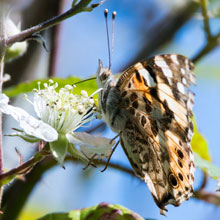
|

|

|
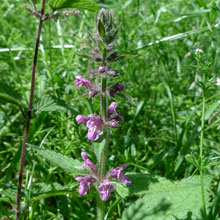
|
John pointed out a
Ladybird on the Woundwort and then, a new sighting for us, a Sawfly
with a bright orange band on its abdomen, aglaostigma aucupariae. From
the east-most hide we could see a large collection of hundreds of
birds, mainly oystercatchers, curlew, and various gulls. According to
one birder there had been a dog walker on the Reserve, apparently
unaware that her or her dog were not welcome there. She had put up the
birds who had then settled on the east scrape. A Curlew made a sudden
landing amongst some Black-tailed Godwits.
| 7 Spot Ladybird |
Sawfly-aglaostigma_aucupariae |
Curlew |
Black-tailed Godwit |

|

|

|

|
A
solitary Sandwich Tern croaked its disapproval as Black-headed Gulls
pestered it as it fed. We searched unsuccessfully for the reported
Little Gull. With so many gulls in a such a small area, it was like
looking for a needle in a haystack. As we left the hides a small flock
of Long-tailed Tits passed across the bushes above us, tweet-tweeting
as the went. At the entrance of the Reserve I noticed some Hairy Tare
at the edges of patches of long grass.
| Sandwich Tern |
1st Cycle Black-headed Gull |
Long-tailed Tit |
Hairy Tare |
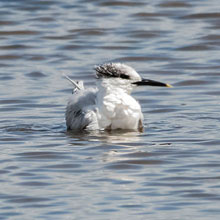
|
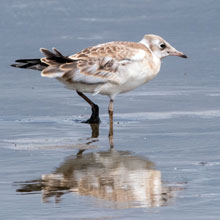
|
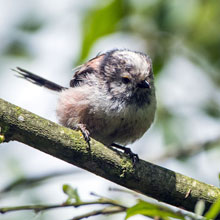
|

|
We
made our final relocation the day to Port Seton knowing that the
incoming tide would have been covering the rocks, encouraging birds to
move inshore. When we got there, the whole expanse of rocks was hosting
over a hundred moulting Eider drakes. There were also Cormorants on the
more distant rocks. A Rock Pipit landed on the sandy shore below the
Promenade. Occasionally a few Common Terns passed beyond the Eider
flock, sometimes diving for fish. One pair of Common Terns (see,
“Pictures of the Week”, below) landed on rocks
about 30m in front of
us, allowing some welcome photo-opportunities.
| Eclipse Eider Duck |
Cormorant |
Rock Pipit |
Common Tern |
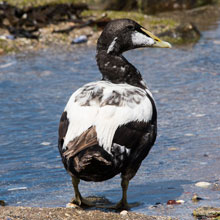 |

|

|
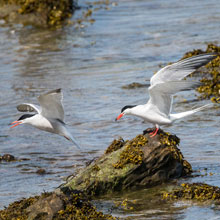
|
We
ended the trip in our usual fashion, with tea and pastries - delicious
strawberry cream tarts. The weather had been kind to us with plenty of
sunshine and only one three-minute light shower at the Scrapes.
We’ve
captured photos of a pleasing variety of sightings, my favourites being
the Butterflies and Moths, and of course, the Common Terns.
Pictures of the Week:
| Eider Duckling |
Female Eider |

|

|
| Red Admiral |
Common Tern |

|

|
23rd June 2019:
Inner
Tyninghame Bay
From the moment I read
on Twitter, “5 Spoonbills
in Inner Tyninghame Bay” there wasn’t much doubt
where we
were going on Sunday. Even with brighter weather predicted for the
southwest, we couldn’t let the opportunity slip of seeing
birds
that were rarely seen north of the border. So after a stop for
breakfast at Dalkeith Morrisons (9.5/10: excellent) we hastily drove
out to the Dunbar area, high in expectation of bagging some nice
Spoonbill shots. It was fairly dull weather to start with, but by early
afternoon it was wall-to-wall sunshine. We parked at the start of Ware
Road, a farm track that leads to the west end of the Inner Bay. Our
first picture taken was of a male Chaffinch lurking in the hedgerows. We
ambled along the road enjoying the rare warm air and sunshine,
surrounded by fields of barley on one side and potatoes on the other. I
recognised the call of a Reed Bunting and, after a short search, I
located it atop of a hedge. In the grassy verges bees were busy amongst
the many wildflowers. I photographed a Buff-tailed Bumblebee feeding on
an umbel of Hogweed.
| Chaffinch |
Potato Flower |
Reed Bunting |
Buff-tailed Bumblebee |

|

|

|

|
I photographed the
hoverfly, Syrphus
ribesii,
on a lovely Wild Rose flower. The hoverfly is also known as the
“Humming Syrphus” or “Common Banded
Hoverfly” (see “Pictures of the
Week”, below).
On the same flower I also snapped a fine Honey
Bee .
It seemed too absorbed in its work to mind a camera lens bearing down
above it. Ahead of us a Yellowhammer was taking a dirt-bath. We did
hear the 'a-little-bit-of-bread-with-no-cheeeeeese' calls of
Yellowhammers as we moved along the road but unfortunately
didn’t
get a better shot as they were hiding under blankets of leaves. I
continued to scan the wildflowers as we went. I was impressed with the
patches of violet-coloured Tufted
Vetch and long
stretches of Green
Alkanet with
their small blue flowers nestling between broad lanceolate
green leaves.
| Honey Bee |
Yellowhammer |
Tufted Vetch |
Green Alkanet |

|

|
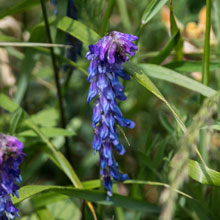
|

|
Another flower of the
countryside present on the field edges was Meadow
Vetchling .
It is a climbing plant with tendrils and has a yellow flower head at the
end of a long stem. A Whitethroat dashed across the road and onto a
nearby fence post. I took several shots of it as I moved ever closer
before it ultimately flew away. Next a Speckled
Wood butterfly glided above
the path before settling on a Gorse Bush. Eventually we reach the Bay
and moved through bushes of Gorse and
Broom
where I snapped shot of a very attractive Broom flower (see
“Pictures of the Week”, below), and also captured a
back-lit seed pods on the same bush. Gorse and Broom look similar as
they are close relatives, but Gorse has thorns and Broom does not.
| Meadow Vetchling |
Whitethroat |
Speckled Wood |
Broom |

|

|

|

|
The view of the Bay,
though spectacular, was down-heartening. Several
hundreds of metres away, in the middle of the sands exposed by the
receding tide waters, there were many birds gathered on the meandering
River Tyne, and within this group were the Spoonbills. We were, of
course, pleased to see them, but they were too far away for decent
pictures.
The Spoonbills were
moving southwards down the Tyne searching for
invertebrates and small fish. It made sense then, for us to move to the
south shore of the Inner Bay, where we might get a closer view. Four
Curlews flew past as we set off. I noticed some Lesser Stitchwort peeking
through the long grass by the footpath. We moved past huge concrete
cubes, part of the WW2 coastal defences
and now overgrown with wild plants. I spotted some Biting Stonecrop on
one block. As we moved, we kept track of the Spoonbills. They were
indeed coming closer. A pair of Mute Swans flew along the river channel.
I snapped them as they past over the Spoonbills.
| Curlew |
Lesser Stitchwort |
Biting Stonecrop |
Mute Swan |

|

|

|
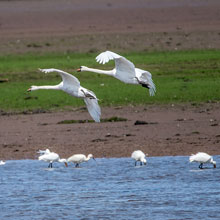
|
We positioned ourselves
by the River Tyne at its closest point to the
shore, hoping the Spoonbills would pass us. Eventually they did. Soon
we were watching then from about 40m away. We wondered if they were all
mature birds. Juveniles’ bills are black and don’t
have the
yellow colouring of the adult birds. Using that indicator, we could see
there were no juveniles. We did catch a shot of a pair of the birds
with a small flat fish (see “Pictures of the Week”,
below).
We watched the birds
pass as they continued their journey down the
river as it wound its way towards the Firth. It was a delightful
experience, helped no end by the very nice summer weather. John
directed my attention to a Little
Egret
in the distance flying across the Bay. Fairly chuffed that
we’d,
for once, achieved our objective of seeing Spoonbills, we started our
return journey to the car. The Stinging Nettles were in flower, as were
patches of Yarrow. We noticed that now the Sun was shining in a clear
blue sky, far more insects were evident on the wildflowers we had passed
earlier. A Small
Copper
butterfly landed just a footstep in front of me on a Meadow Buttercup.
It looked a bit worse for wear. I also caught a Buff-tailed Bee on White
Clover (see “Pictures of the Week”, below).
| Little Egret |
Stinging Nettle |
Yarrow |
Small Copper |

|
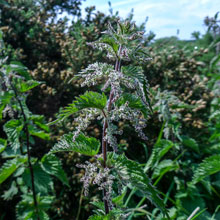
|

|

|
A large Mute Swan swam
down the River, away from the Spoonbills. They
did not seem to mind each other as they passed. A pair of twittering
Goldfinches flew onto branches of Broom and stayed there long enough for
a quick shot. On the water’s edge a wee male Pied Wagtail
also
gave a few tweets before foraging the damp sand and rocks for tasty
morsels. We were pleased to come across some Common
Blue Damselflies
hovering over the footpath before they rested on blades of grass.
| Mute Swan |
Goldfinch |
Pied Wagtail |
Common Blue Damselfly |
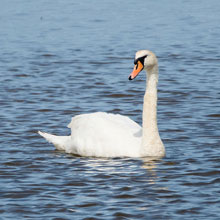
|
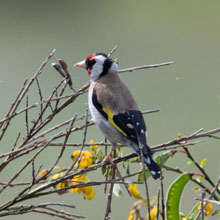
|
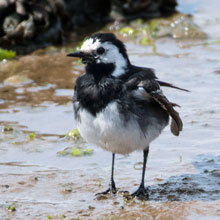
|
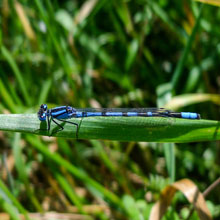
|
We returned down Ware
Road, past a Spear Thistle just ready to bloom. And in the edges of the
fields of barley a few Large
White butterflies
were fluttering from flower to flower sampling the nectar. There were many
Scentless
Mayweed,
members of the Daisy family, in the relatively bare field edges. The
final shot of the trip was of an evasive Great Tit, possibly, from its
dull colouring, a juvenile, peeking out from the hedgerow.
| Spear Thistle |
Large White Butterfly |
Scentless Mayweed |
Great Tit |

|

|

|
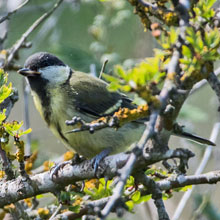
|
We certainly enjoyed our
tea this week. The iced cinnamon Danish
pastries went down with a great deal of satisfaction as the visit had
been fairly triumphant. Not only had we got many pictures of the
Spoonbills but we’d seen a rich variety of flowers, insects
and
birds. And, by law of averages, it had to happen, the weather was great!
Pictures of the Week:
| Syrphus
Ribesii |
Broom |

|
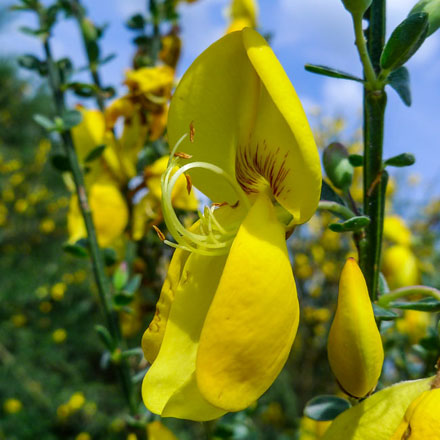
|
| Spoonbill |
Buff-tailed Bumblebee |

|

|
16th June 2019:
Seafield
Pond and Dunbar
Harbour
The brightest and
shower-less weather in Central Scotland was predicted
for the east, so I opted for the Dunbar area. Seafield Pond is a pretty
location set beside a quiet Holiday Park and overlooking Belhaven Bay,
it is home to many birds which made it a suitable choice of venue on
Sunday. It is the site of a vast clay pit used by the 19th century Seafield
Brick and Tileworks .
Our breakfasts in Dalkeith Morrisons were excellent (9.5/10) which set
us up for day of exploration and discovery. On the short walk from the
car park to the Pond we passed some very active House Sparrows, busy
feeding their fledglings. One particular wee cock Sparrow was caught
obviously taking his Fathers’ Day duties very seriously (see
“Pictures of the Week”, below). At the Pond I
snapped a
Sedge Warbler similarly occupied in the tall reeds, beak stuffed with
Damselfly (see below also). A busy, disheveled Blue Tit made repeated
trips between the reeds and nearby bushes as it fed its brood. Less
frantic parenting was going on at the pondside where a pair of Mute
Swans guarded their large family of cygnets.
| House Sparrow |
Sedge Warbler |
Blue Tit |
Mute Swan |

|

|

|

|
A strangely attractive
female Mallard caught our attention as it
dabbled in the shallow water. A fine-looking drake Mallard posed on the
grass before high-tailing it into the water, evading the threat posed
by a passing dog. I noticed a solitary Wigeon asleep on the island,
surrounded by Mallards. It seemed that all the reed beds around the
Pond had Sedge
Warblers
darting through them, each clutching invertebrates in their beaks,
some, I would presume, anxiously searching for their fledglings.
| Female Mallard |
Mallard Drake |
Wigeon |
Sedge Warbler |
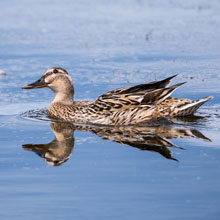
|

|

|
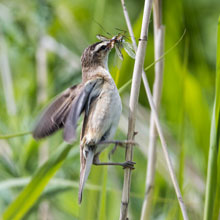
|
A bold Reed Bunting
assumed his stance on a tall twig, only to be chased by a Sedge Warbler
soon after. I noticed a sculpture
at the back of the pond. It depicted a naked man with a fish on his
head. As I scanned the sky following how the sun might break through
the clouds, I noticed a halo around the sun. This was caused by ice
crystals
high in the atmosphere The familiar call of the Chiffchaff
emanated
from the top of high trees on the east boundary of the park. I managed
a recognisable shot despite the light being poor on the silhouetted
bird.
| Reed Bunting |
Scultpure |
Ice Crystals |
Chiffchaff |
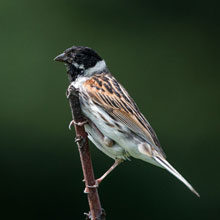
|
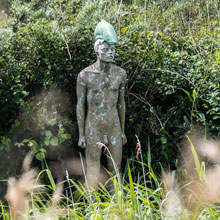
|

|

|
A Rabbit
bolted out from under a bush and legged it over to the wood on the
other side of the park. The Normans brought over Rabbits from France in
the 12th century. These were kept for their meat but escaped animals
have thrived in the wild until present day. A bird then appeared on the
reeds. As we left the Pond area I got a photographs of a ragged-looking
Sedge Warbler and a Jackdaw foraging in the short grass.
| Rabbit |
Sedge Warbler |
Jackdaw |

|

|

|
We made the short drive
along Back Road into Dunbar and down to the historic Victoria
Harbour. As we parked we
could hear the loud and persistent calls of the very many Kittiwakes (named
after their calls). Most of the birds were nesting on or around the the
ruin of Dunbar Castle. As we watched birds were continually arriving
(see “Pictures of the Week”, below), delivering
their food
to young birds and then flying off again to repeat the exercise. The
passing of food between birds was a bit of a performance as the young
bird loudly demanded the payload be delivered as it rubbed its bill
over its parent’s. On the Harbour-master’s roof, a
Rock
Pipit landed and looked over to me as if I was impeding
it’s progress. I took it picture and moved away. The next
bird I
thought worthy of a photo was a young Great Black-backed Gull
perched on one of the fishing boats that were moored on the harbour.
| Kitti |
wakes |
Rock Pipit |
1st Cycle Great Black-backed Gull |

|
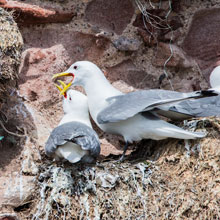
|
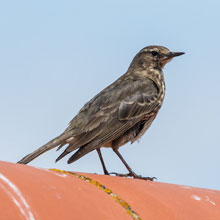
|

|
Outside the
Battery
I snapped a strikingly beautiful Poppy plant (see also
“Pictures
of the Week”, below). A male Pied Wagtail tweeted its
presence
onto the scene, although it didn’t hang about, being scared
off by
some noisy humans. Inside the Battery area there is a Coastal
Garden
- well kinda. It is a rectangle of clean pebbles into which some wild
species of flowers have been neatly inserted. I was pleased to see a Painted
Lady,
the far-travelled butterfly, finding some of the plants worthy of
inspection. Most of the plants on show weren’t native to the
UK
but I was particularly attracted to the Sea
Holly,
but on researching it, it seems to be an Alpine species,
whose
natural habitat is in a mountain environment, i.e. it isn’t a
coastal plant.
| Opium Poppy |
Pied Wagtail |
Painted Lady |
Alpine Sea Holly |

|

|

|

|
Looking over the tall
breakwater wall at the north side of the Harbour
we could view the Gripes and Castle Rock, more nesting areas of Shag,
Herring Gulls and Kittiwakes. We were impressed with the fluffy grey
Herring Gull chicks. John spotted the head of a Grey Seal bobbing in
water. It was only visible for a minute before diving off out of sight.
| Shag |
Herring Gull Chick |
Herring Gulls |
Grey Seal |

|

|

|

|
John directed my
attention to a nesting Shag where the chick had
appeared beside its parent. It certainly won’t win any bonny
baby
competitions, but I’m sure its mummy loves it. I caught some
shots of an incoming Shag that didn’t feed any other bird
when it
landed. We returned to the car, retracing our path around the Harbour.
I saw another immature Great Black-backed Gull, this time a third year
bird, with adult plumage just beginning to form. At the car, a pair of
juvenile House Sparrows explored the dusty terrain while the adults had
dust
baths which
helps them keep their plumages healthy.
| Shag |
Shag |
3rd Cycle
Great Black-backed Gull |
Juvenile House Sparrow |
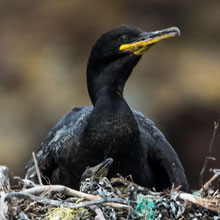
|
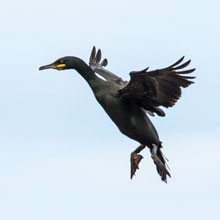
|

|

|
After the dearth of
birds last week at JMCP, our bird count at Dunbar
and Seafield Pond was certainly greater, and we had much better light,
although we often had to wait on gaps in the clouds letting
the
sunlight through. Very fine Iced Cinnamon Danish pastries were consumed
with our teas, rounding off a very satisfactory afternoon in East
Lothian.
Pictures of the Week:
| House Sparrow |
Sedge Warbler |

|

|
| Kittiwake |
Opium Poppy |

|
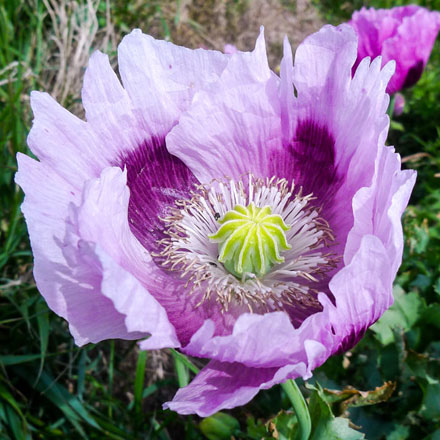
|
9th June 2019:
John
Muir Country Park
Fair weather was
predicted for Scotland’s central belt and social
media reports of bird activity were very sparse, so our decision of
where to head on Sunday was based on finding a location we
hadn’t
visited in some time. John
Muir Country Park
(JMCP) fitted the bill as we last visited there 6 months ago.
(We
have always referred to the site as Tyninghame Bay, but because
everybody else seems to call it JMCP, then to avoid confusion, we will
too, although the Park covers a much wider area than Tyninghame Bay).
We called in at Dalkeith Morrisons for wee breakfasts (9/10: excellent
food but we had to wait for it), and then drove up the A1 towards
Dunbar, and arrived at a cloudy JMCP. Undeterred we set off across the
salt marsh towards the beach. Our first snap was of a disgruntled Wood
Pigeon we put up when I moved towards a huge patch of Crosswort in the
long grass on the edge of the salt marsh. We picked our way across the
100m of damp ground of the marsh. In some short grass we passed some Fairy Ring Champignon , Scotch Bonnet. Also in the damp grasses there were single
Thrift flowers dotted around, with only a few of the more usual dense
patches.
| Wood Pigeon |
Crosswort |
Fairy Ring Champignon |
Thrift |

|

|
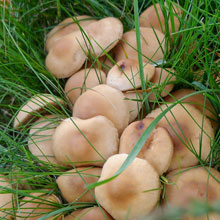
|

|
On the edge of the dunes
there were the familiar dainty blue flowers of
Field Forget-me-nots, poking through the wiry grass. Also seen were the
small white flowers of Common
Mouse-ear . Also
plentiful were the very attractive pink-purple, pea-like blooms of Common
Vetch Just
before the dunes John saw a Cinnabar
Moth.
It settled low in the grass but I managed to persuade it onto my warm
finger where I took a quick shot or two (see”Pictures of the
Week”, below). I then noticed a yellow and black-banded
caterpillar crawling along a grass stem. It was the larva of another
moth, the
6-spot Burnet Moth larva.
| Field Forget-me-not |
Common Mouse-ear |
Common Vetch |
6-spot Burnet Caterpillar |

|

|

|

|
While I was taking
pictures with my LUMIX LX5, John took my Nikon D500
and had at go capturing some images. He caught a Red-tailed Bumblebee
on Bird’s-foot Trefoil, the first of four bees
we’d see, and a Meadow Pipit studying us from the footpath.
Eventually we reached the end of the path and moved out onto the Beach
and seashore. We proceeded west towards the mouth of the River Tyne. We
had been hoping to see some wading
birds, but were to be
disappointed. All we saw were a few Herring Gulls and a single
Cormorant feeding 30m off shore.
| Red-tailed Bumblebee |
Meadow Pipit |
Herring Gull |
Cormorant |

|

|

|
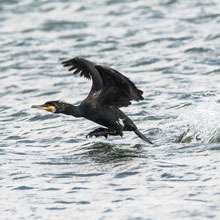
|
The view west across
Tyninghame Bay showing the Bass Rock on the right, and important
nesting ground of 150,000 of breeding Gannets.
As we walked the shore
there was a steady stream of Gannets,
quite far out, mainly passing eastwards. Occasionally a few were close
enough for some record shots. The one below is of a 3rd year Gannet,
with dark brown and white-marked wings. They will have full adult
plumage next year. We were disappointed, but with understanding, to find
the west extreme of the shoreline sectioned off to protect breeding
Terns, particularly the Little Tern. We therefore cut across the dunes
into Inner Tyninghame Bay, the tidal Estuary of the River Tyne. As we
crossed the dunes we saw a lot of Skylark activity, so much so the John
expressed his annoyance at the constant twitterings of the hovering
Skylarks. I did managed a shot of one of them as it rose into the air
above us. John again took my camera as I once again searched for flowers
and insects with my “wee” LUMIX. He got a nice shot
of a
Meadow Pipit on some tall vegetation. I, in the meantime, snapped some
shots of one of the many Common
Storksbill
plants that were indeed common on and around the rough path.
| 3rd Cycle Gannet |
Skylark |
Meadow Pipit |
Common Storksbill |
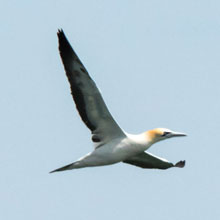
|

|

|

|
Also on the path I
noticed a couple of Snails, the White-lipped
and Dark-lipped Snails. Near the snails was a fairly tall,
robust-looking plant with wine coloured conical flowers. This was Houndstongue. Somewhat more attractive, was the
exotically-named Viper’s
Bugloss.
I got a few nice shots of a White-tailed Bumblebee sampling the nectar
of its many flowers (see”Pictures of the Week”,
below).
| White-lipped Snail |
Dark-lipped Snail |
Houndstongue |
Viper's Bugloss |

|

|

|

|
The tide was low, so the
vast expanse of Inner Tyninghame Bay, which is
totally flooded at high tide, had its sands exposed with only the narrow
waters of the River Tyne flowing to the Firth of Forth. On the river
were a few Mute Swans and a pair of Shelducks, but again, no waders. We
picked our way across the soft damp sands of the Bay towards the mouth
of the Hedderwick Burn. From there we walked the north perimeter of the
East Links Family Park on our way back to the car park. I photographed
some Hedge Mustard by the path and also some pretty Red Clover.
| Mute Swan |
Shelduck |
Hedge Mustard |
Red Clover |

|

|
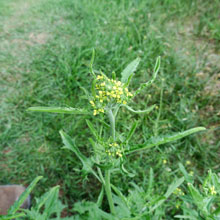
|

|
Midway along the path
adjacent to the Family Park we found some
interesting flowers and insects. A Dog Rose bush seemed irresistible to
bees. Many of the cup-like roses contained a buzzing bee or two that
seemed intoxicated by the experience of being immersing in pollen while
sipping nectar. The pictures below show two such nectar junkies, a Honey
Bee
and a White-tailed Bumblebee. I also photographed a Common Carder
Bumblebee (see”Pictures of the Week”, below) on Red
Clover.
We also saw Red and White Campion, although they didn’t seem
to
attract any insects.
| Wild Rose (Dog Rose) |
Honey Bee |
Red Campion |
White Campion |
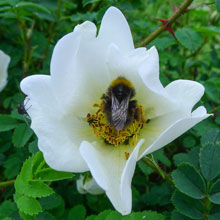
|
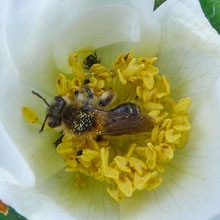
|

|

|
John spotted a dinky wee
Marmalade Hoverfly feeding on Vipers Bugloss.
While I photographed it, a black fly, nemorilla floralis, landed on my
finger. So I recorded the moment. Our final flowers of the visit were just
before the toilet block, where we saw Bittersweet and Common
Restharrow. Our final capture was quite pleasing. It was the beetle,
amara commonus (see”Pictures of the Week”, below).
| Marmalade Hoverfly |
Nemorilla Floralis |
Bittersweet |
Common Restharrow |

|
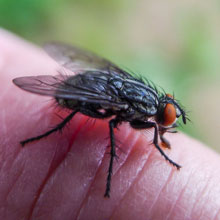
|

|

|
It would be fair to say
that the birds took a back seat for this visit.
However, the flowers and invertebrates that drew our interest left us
satisfied with efforts. Our tea was accompanied by Danish apple lattice
pastries. A very satisfactory end to a satisfying day.
Pictures of the Week:
| Cinnabar |
White-tailed Bumblebee |

|
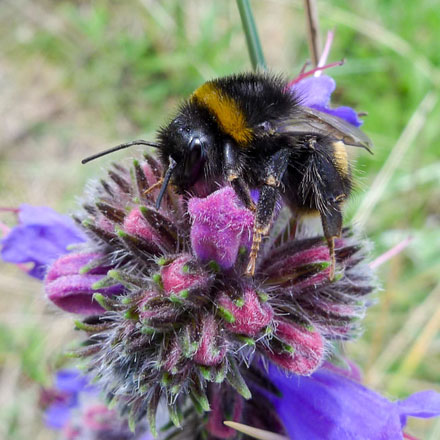
|
| Common Carder Bumblebee |
Beetle - amara commonus |

|

|
2nd June 2019:
Musselburgh and
Port Seton
We went to Musselburgh
and Port Seton on Sunday. The weather forecast
wasn’t encouraging but we approached the visit as something
of a
challenge, hoping that we’d see enough to report in this
blog. Of
course we stopped off at Dalkeith Morrisons for our customary breakfasts
(9.5/10: excellent fare) before driving to the the mouth of the River
Esk. John spotted a female Goosander moving down the river with her
chicks. As we walked briefly upstream to photograph them, I noticed a
nice Common Mallow plant overhanging the river bank and also some
Dove’s Foot Cranesbill. Conditions were dim and the
Goosanders
were near the opposite bank but I managed a few nice shots of the cute
chicks.
| Common Mallow |
Dove's Foot Cranesbill |
Goosander and |
Chicks |
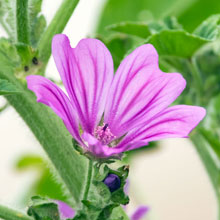
|

|
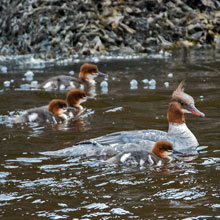
|

|
I came across some Henbit
Deadnettle .
It was poking out from under the fence wire. We next set off on our
usual journey along the sea wall to the Scrapes. The tide was nearly at
its high point so we hoped that some of the birds that had been feeding
on the sea shore would have sheltered in the Scrapes. A bold wee House
Sparrow appeared to wish us well from its perch on the riverside fence.
On a telephone wire high above the Cadet Hall boundary fence I spotted
a pair of Barn Swallows taking a wee rest between spells of hunting
flies (Also see “Pictures of the Week”, below). Just
past
the Hall there were quite a few female Eiders with their ducklings
gathered near the shore. Annoyingly though, a pair of beachcombers
thought it would be a great place to skim stones across the water. They
did a great job in scattering the Eiders.
| Henbit Deadnettle |
House Sparrow |
Barn Swallow |
Female Eider and Chicks |
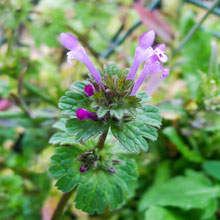
|
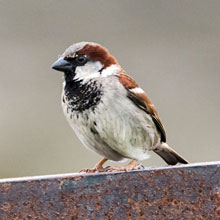
|

|
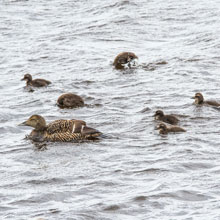
|
After I captured a
fairly decent image of a handsome Herring Gull that
circled overhead, a little clump of fungi caught my eye. These were
Butter Caps, Rhodocollybia butyraceae. A bit further on, a tiny
7-spot
Ladybird was scaling the relative heights of Sea Plantain flower stems.
Below the sea wall a female Eider was taking a nap.
| Herring Gull |
Butter Cap |
7 Spot Ladybird |
Eider |

|

|

|

|
I caught a pleasing shot
of Reed Bunting landing on a Wild Rose bush
(see “Pictures of the Week”, below). A Carrion Crow
winked
as I took its photo, its “nictitating
membrane”
is obvious in the picture below. I surprised a pair of female
Goosanders that were just below the sea wall. However, apart these and
large numbers of Eider scattered along the coastal waters, there
wasn’t much else of note as we looked seawards. But as we
left
the wall and walked towards the entrance to the Scrapes we did find the
path-side vegetation more productive because we found a few interesting
insects there. First of these was a Soldier Beetle, cantharis
nigricans, which is fairly widespread throughout the UK. It is a
carnivore that scours hedgerows and flower meadows for smaller
insects . Also in
the same grassy area we were joined by the Cranefly, tipula
vernalis, another common
insect of flowery meadows as they dine on nectar.
| Carrion Crow |
Female Goosander |
Soldier Beetle |
Cranefly, Tipula Vernalis |

|

|
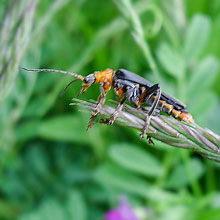
|

|
The next insect we
discovered was the dangerous-looking Dance Fly, empis
opaca,
on some Spring Vetch. It has a dagger-like snout that it uses on its
prey. It has an sinister courtship ritual that necessitates presenting
a potential mate with a dead insect. Just as I captured pictures of the
Dance Fly we found that a lot of Dandelions had small wasp-like insects
feeding on them. They were in fact Sawflies, tenthredo
arcuata
feeding on nectar. They also eat smaller insects. As we continued
towards the Scrapes we were overtaken by a Large White butterfly (see
“Pictures of the Week”, below) that landed,
conveniently
for us, a few metres away on a flower. I snapped a few shots before it
continued on its way. Our final insect was a Whited-tailed Bumblebee on
the Spring Vetch.
| Empis Opaca |
Tenthredo Arcuata |
Large White Butterfly |
White-tailed Bumblebee |
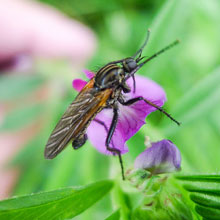
|

|

|

|
As we stood at the
entrance to the Scrapes and looked up the path we could see an adult
Starling feeding
its fledgling. It fairly rammed a bundle of worms down its throat.
| Starling and |
Fledging |
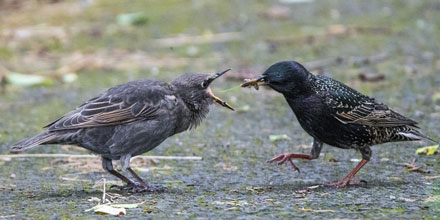
|
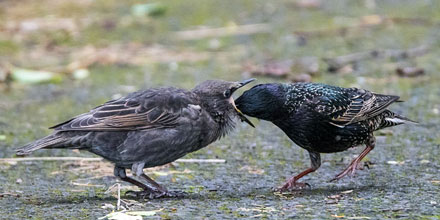
|
From the first hide
(left-most) we could see the usual Oystercatchers,
though not in the usual very large numbers. A pair of Shelducks were in
the middle of the flock nipping any birds that got in their way. A pair
of Gadwall landed fairly close, to the right of the hide. The female
Shelduck, probably having had quite enough of the
Oystercatchers’
antics, plodded along the poolside away from the flock.
| Oystercatcher |
Shelduck |
Gadwall |
Female Shelduck |

|

|

|

|
In the middle of the
second scrape a few Bar-tailed
Godwits
were feeding. They included one that was in its rust-coloured breeding
plumage. Eventually we left that hide for the centre hide. On the way,
we came across a twittering Goldfinch high in a tree. And, in low
branches directly above the path as we walked, a Willow Warbler nipped
between branches, not too concerned we were trying to photograph it.
| Bar-tailed |
Godwit |
Goldfinch |
Willow Warbler |

|

|

|

|
From the middle hide we
saw Curlew positioned at the back of the
Scrapes. While scanning the area using binoculars John caught sight of
a female Pheasant watching a the back of one of the Scrapes. We hear
the male but could not spot it. Despite being quite far off I managed
quite a good record shot. I then noticed, in the middle of the closest
Scrape, a female Mallard with her brood of ten ducklings . They seemed quite a handful, and quite
big, a testament to their mother’s watchful eye.
| Curlew |
Female Pheasant |
Female Mallard |

|

|

|
As we returned back the
way we’d come, we met a Reed Bunting on a
fence, probably the same one we had seen earlier. I also photographed a
trio of nice wildflowers. First of these was White Campion with a Sawfly
on one of its petals, the same species we’d snapped earlier.
The
next was Oxford Ragwort, a flower with an interesting history . I noticed later it hosted some Flea
Beetles ,
possibly chrysolina oricalcia. They were very tiny (1-2 mm) so
identification was difficult from the picture alone. The third
flower
we came upon was a nice specimen of Sea Plantain.
| Reed Bunting |
White Campion |
Flea Beetle |
Sea Plantain |

|
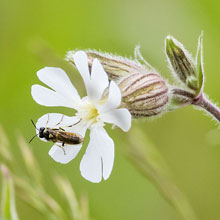
|

|
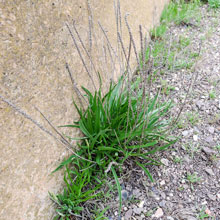
|
We returned to the car
to find a large flock of Mute Swans gathered at the river mouth:
As the tide neared its
peak, I reckoned the rocks at Port Seton could
hold birds “forced in” by the advancing waters. We
found
this to be the case and soon after arrival I had got some decent
pictures of Turnstones. They had to share the diminishing rockscape
with Herring Gulls and Eiders (see “Pictures of the
Week”,
below). A pair of Gannets appeared and dived for fish a few hundred
metres offshore. Eventually one passed close enough for a record shot.
Our final capture was of a pair of Sandwich Terns that passed by. I was
expecting more Tern activity but perhaps it was a bit early in the
season.
| Turnstone |
Turnstone |
Gannet |
Sandwich Tern |

|
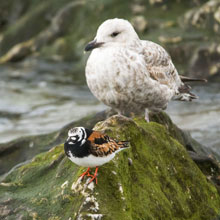
|

|

|
The gloomy view of the
three Forth Bridges some 20 miles away:
Well, despite the rather
poor light, the rain had stayed off and we had
gathered a lot of photos- over 400. So with so many pictures of birds,
flowers, insects and views we agreed it had been a successful visit. Our
titbits this week were delicious strawberry tarts. As we were sitting
on the promenade wall at Port Seton, 3 birders appeared with scopes.
They were tracking 5 Spoonbills that were expected to pass by
imminently. It needed more than that to tear us away from our tea and
strawberry tarts. The Spoonbills didn’t turn up and the
birders
left as quickly as they’d arrived. We left satisfied with
another
successful visit, but still craving better light.
Pictures of the Week:
| Large White Butterfly |
Barn Swallow |

|
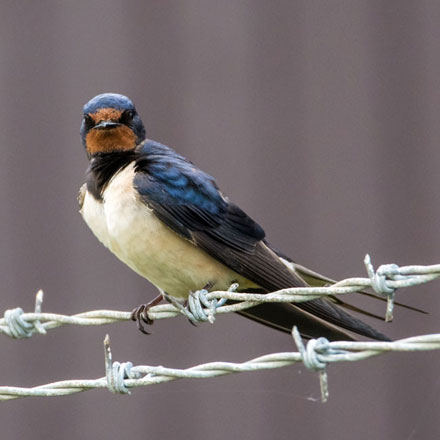
|
| Reed Bunting |
Female Eider |

|

|
Back To Top
|

